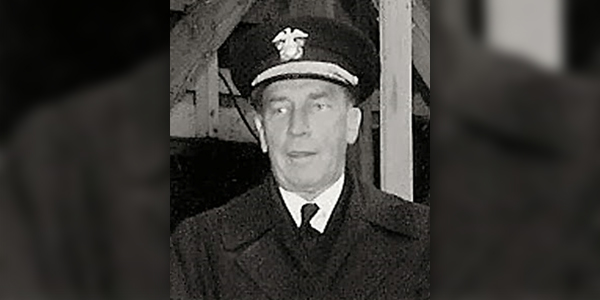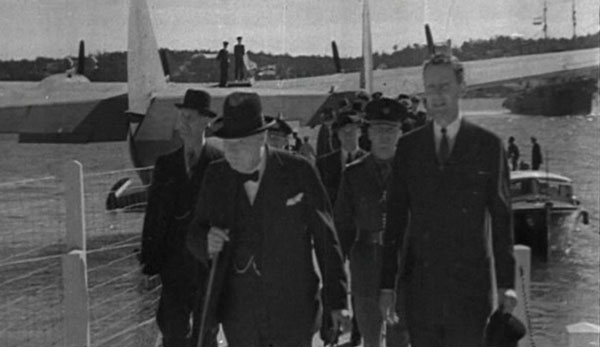History: Survivors & Bermudians During WWII
[Part four of a series by Eric T. Wiberg]
On the 3rd of July 1942 the City of Birmingham’s rescuers deposited 372 survivors in Bermuda, a week earlier, on 28th June the Jagersfontein’s rescuers dropped off 99 more, and 62 arrived in two airplanes and a ship from USS Gannet on 8 June 1942.
Those landed in St. George’s had the privilege of riding on the railway from that end of Bermuda to Hamilton – in one instance the railway was started “after hours” at night for such a journey. The landing of 256 survivors from the Canadian passenger ship Lady Drake illustrates the kind of reception which even war-beleaguered Bermuda could lay on for strangers to their shores:
There was a grand reception for the USS Owl and her survivors when they arrived at Shed #6 in Hamilton at around 10:30 am that morning – May 6th 1942. The Mayor of Hamilton, S. P. Eve was on hand, along with the Governor of the colony and the Commandant of the US Naval Operating Base.
According to the Colonist Daily, “On the dock as the rescue ship warped in were officers of the various British and American Services in Bermuda. Along Front Street were lined ambulances from the U.S. Mobile Base Hospital. The Director of Health, Dr. Henry Wilkinson, and civilian, army and navy doctors were there.”
The article continues; “The grim event was not without its light touch. Among the survivors was a Greek prisoner who was in the brig of the torpedoed ship. He is now comfortable in Hamilton Gaol.” The reporter also picked up on the exchange between a passenger named Miss Canfield and her rescuers:
“As she came ashore, her lifebelt still in her hands, Miss Canfield turned towards the rescue ship where crewmen of the torpedoed vessel were lined up on deck. “Keep your chins up boys,” she called out. “Are you alright?” “You bet,” came the response from the grinning seamen, “You’ve got what it takes, lady!”” Since Miss Canfield had been a guest of Police Constable and Mrs. Gooch of Pembroke Parish, it is presumed that she returned to stay with them.
Admiral Jules James, Commandant of NOB Bermuda, who came aboard USS Owl on arrival in Hamilton with survivors of the Lady Drake on May 8, 1942 [photo courtesy navy.togetherweserved.com]:
By 10:45 all the survivors were disembarked, and at 11:30 Admiral Jules James, the Commandant of NOB Bermuda was aboard, followed three minutes later by His Excellency Viscount Knollys, Governor of Bermuda, who “came aboard and thanked the ship for the assistance rendered. A “Well Done” was received from the Admiral.”
While it is possible to list most of the several places the men were put up in Bermuda, it is only partially possible to list the many individuals who helped the survivors of the Lady Drake. Fortunately for the eight hospital cases, “None of these is believed to be seriously injured.
There were also a few exposure and shock cases of a minor nature.” There was a single US citizen aboard and he was met by Mr. Alonzo B. Cornell, Field Director of the US Red Cross, which used the United Services Organization’s Club in The Flatts.
Others of the men were accommodated at the United Services Club at the Hamilton Hotel. L. N. “Dickie” Tucker made what room he could at the Bermuda Sailor’s Home, “cramming his premises with survivors.” The Naval Recreation Rooms were made available as were local hotels.
Other hostelries made available were the A.M.E. Lyceum on Court Street, at the A.M.E. Church [Rev. D. M. Owens, D.D. providing the welcome]. There the men were provided with sandwiches, soup and coffee, clothing and cigarettes.
Lady Knollys, wife of the Governor visited the men at the Lyceum to provide “ditty bags” and chat with the survivors. This was a distribution point for gifts from citizens and merchants. Gift boxes included soap, handkerchiefs, shaving kits, and cigarettes.
A subscription was begun to raise funds for the survivors and by the first afternoon it had reached 30 British Pounds. Survivors also went to the Canadian Hotel and the Church of God on Angle Street, Hamilton. The proprietor of the Canadian Hotel, James Richards, “spent a considerable sum for clothing for the survivors.”
For the officers Mrs. A. B. Smith provided the use of her home, Inverness, in Warwick Parish. The officers who stayed there are reported on 20th of May 1942 to “have expressed their keen joy of the place. It is like home to them. The cottage has been supplied with a cook and inhabitants of the district are doing all they can to make the stay of the survivors a pleasant one.
Governor Knollys escorting Prime Minister Sir Winston Churchill onto Bermudian soil on January 15, 1942:
Each day vegetables are brought to the cottage by neighbours and the environment for the officers is a particularly satisfactory one. Moreover, the cottage is conveniently located near the ferry.”
On Wednesday 13th of May the Royal Gazette and Colonist Daily ran a column entitled “U.S.O. club News” in which they attempt to thank some of the families and individuals “who contributed so much to the comfort of the survivors.”
The list reads like a “who’s who” of Bermudian society: Mrs. J. J. Outerbridge, and “Mesdames Earl Outerbridge, Manuel Nunes, Leonard Gobbons, Ernest Larry, Stalker, Richard Rutherford, B. C. C. Outerbridge, Lauchlin MacDougall, Randolph Tucker, Sheila West, Dorothy Ann Outerbridge and Jessie Fleming. Miss Thomas and Miss Vogan, District Welfare Society Nurses, Mrs. Powell Chrichton and the American Emergency Relief Fund for 6 dozen sheets and pillow cases,” and the Bermuda Women’s Auxiliary Force [B.W.A.F.] “who gave pyjamas and slippers for all the men.”
Others mentioned were Mrs. George Rubick, Mrs. Kent, Mrs. Ethel Tucker, Mrs. Horace Pearman, Miss Zadiee Penniston and G.S.O. girls the Misses Nadya Gardner and Winnie Haskell.”
There is even a letter cited from survivors “on the point of departure” that may [or may not] have been from survivors of Lady Drake. It reads: “It was not only what you did for us, the innumerable kindnesses which we shall all remember, but the spirit of friendly anticipation of our wants which made our visit to Bermuda so delightful. If this is an example of Allied co-operation such a team is bound to win.”
Captain Warren Brown Sr. wrote the following letter to the author in May 2014: “Survivors were looked after by The Bermuda Sailor`s Home. Their address is now 22 Richmond Road, Hamilton. Many survivors were put up at Westmeath guest house. I met many of them as the building belonged to Stanley Conyers and his son was one of my best friends. As a consequence I was often over there.
Look up the Ladies Hospitality Organization in Bermuda. Although not mentioned, my mother and father and a Mrs. Bridges were the ones that carried out most of the work in looking after the sailors. I spent many an evening there helping my parents. We also always had at least two sailors staying at our house. They usually did not say a great deal about their role as everything was always hush, hush.”
St. Paul’s A.M.E. Church in Hamilton, where members of the Lady Drake’s crew were tended to and housed in May 1942:
Although Bermudians were already hard-pressed due to population spikes, and though in the cases of the Freden, Anna, Lady Drake and City of Birmingham the loss of the ships represented a significant disruption of the supply chain to the island, the islanders put on a brave face and got right down to the work of accommodating survivors, passengers, servicemen and merchant sailors alike.
It was no easy task, but the sailors were on the front lines of the Battle of the Atlantic and needed to be returned to vessels to carry the war and its materiel to Europe.
Survivors, though often dazed, sunburned, and dehydrated, spoke glowingly of their time on the island and their treatment by its people. Though comparatively a side show to the larger war, Bermuda was at one point in 1942 virtually encircled by U-boats, which used Gibbs Hill Light as a navigational fix.
Because of censorship the extent of this siege may have been little known at the time except for the arrival of 1,224 survivors, however now is as good a time as any for the facts to become known, particularly as the survivors are embarking on final voyages of their own.
This article is dedicated to the memory of Capt. Warren A. Brown, Sr., who immeasurably helped the author’s sailing career.
- Eric T. Wiberg is an author, historian, and researcher who has published nine books under four titles. His work can be followed on his personal website and on his U-Boats Bermuda blog.




